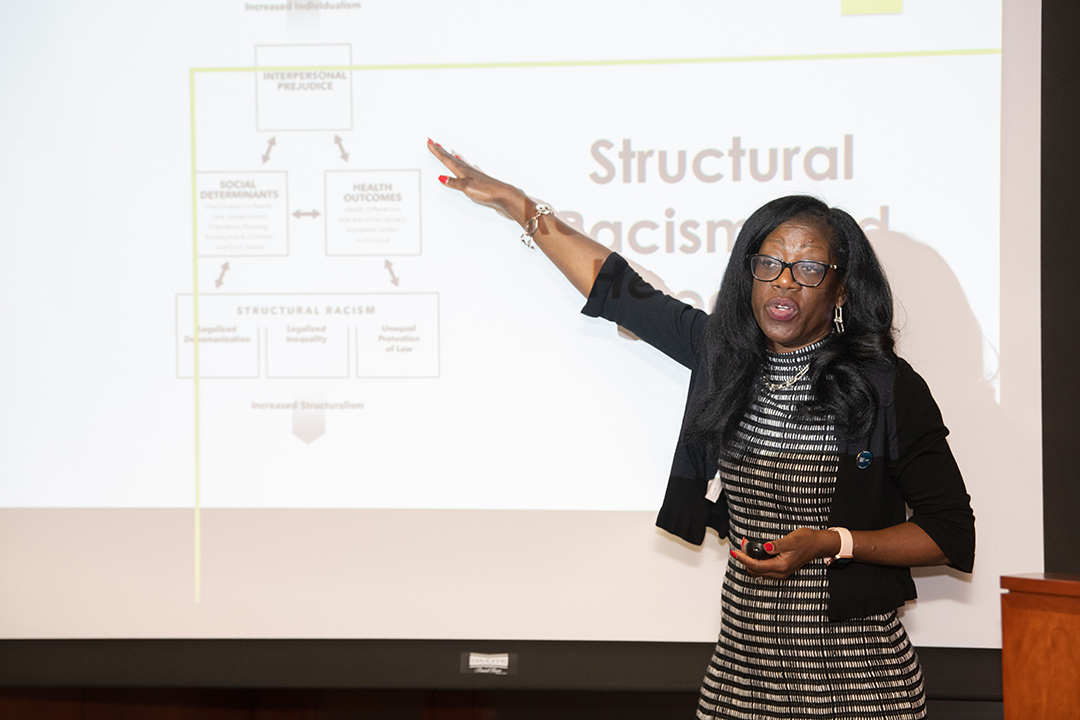By Greg Varner
Data shows it in black and white: Black and brown people die sooner than white people of the same ailments. The health of minority populations is undermined by racial inequality, said Dayna Bowen Matthew, dean and Harold H. Greene Professor of Law at the George Washington University Law School.
Matthew gave the keynote address on Friday at GW Law’s 2022 Health Law Symposium, a gathering of local and national experts dedicated to this topic. Her new book, Just Health: Treating Structural Racism to Heal America, was published in February. Matthew is recognized as an expert on disparities in health, health care and the social determinants of health; her previous book is the bestselling Just Medicine: A Cure for Racial Inequality in American Health Care.
In brief introductory remarks, GW Law professor Spencer Overton praised Matthew for “her leadership, her vision, her energy, her smarts and her emotional intelligence” and said her work on health inequalities has created a roadmap for policymakers to improve the lives of citizens.
“Health is a byproduct of justice,” Matthew said, citing the work of philosopher and bioethicist Norman Daniels. “If we truly had a society where all people were treated equally, we would have a healthy society.”
Pointing to examples to illustrate her thesis, Matthew said that Japan, for example, is a developed country with a low rate of income inequality and a correspondingly low rate of disparity in health outcomes. She added that systemic racism was created by the law, which means the law can dismantle it.
“Structural inequality leads to predictable, replicable ends,” Matthew said, before showing how this truth is starkly reflected in health care outcomes. In the U.S., the people most negatively affected are African Americans, Indigenous peoples and Latinos.
Looking at the COVID-19 pandemic, Matthew presented data showing that people of color have died at higher rates than whites from the disease. They are more likely to live in more densely crowded neighborhoods and work at jobs that can’t be done remotely.
Structural racism, Matthew said, affects where you eat, where you live, where you work, and where you go to school. It creates a hierarchy determining how resources, opportunities and power are allocated. People at the top of the hierarchy enjoy better schools, better food, better jobs, better housing and longer life.
Matthew reminded her audience that structural racism is not the sort of prejudice we see in extreme behavior, but rather the root cause of many of our social problems and the foundation for prejudice.
The law, she said, invented structural racism by legalizing dehumanization, legalizing inequality and providing unequal protection for citizens based on their race.
“Lest you think that went out with colonialism, let me assure you that legalized dehumanization is alive and well today,” she said, pointing to examples where people of color in Alabama weren’t provided with a sewer system and residents of Flint, Michigan, weren’t provided with access to clean drinking water.
As an example of unequal protection of the law, Matthew pointed to the fact that Black and white people use marijuana at about the same rate, but Black individuals are more often sent to prison for this drug use, in numbers wildly disproportionate to their presence in the population at large.
“Law is the mechanism that institutionalizes white superiority,” Matthew said. “Law is the mechanism that can dismantle it.”
In a brief question-and-answer period after her talk, structural impediments confronting students of color interested in studying the law were discussed.
“Admission to law school is a political act,” Matthew said. “Work to make minorities the guardians of the valuable asset that is a legal education, and then increase the diversity of those who have access to that education. And then talk about the things that matter in the classroom.”



